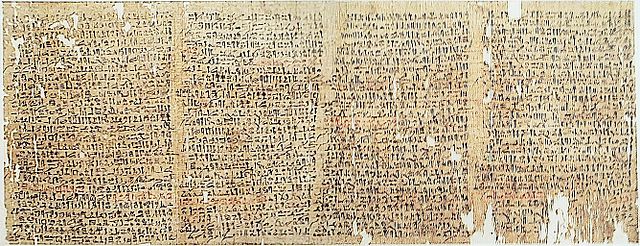The Westcar papyrus (also known as “Three Tales of Wonder from the Court of King Khufu”) is composed of twelve rolls of papyrus written during the Hyksos period but recounting stories which are thought to date to the Middle Kingdom. It centers around four stories told to the Old Kingdom pharaoh Khufu by his sons and a final section telling of the birth of the first three kings of the fifth dynasty (Userkaf, Sahure, and Neferirkara Kakai).
Some commentators have ventured that the poor handwriting and high numbers of mistakes in the text suggests that the papyrus was a copy done by a student as part of his studies.

- Story of Imhotep
- Story of the wax crocodile
- Story of the turquoise pendant
- Story of Khufu and the magician
- Story of the birth of the three pharaohs
The Story of Imhotep
The first story of the Westcar Papyrus is told by an unknown son of Khufu (possibly Djedefre), but only a few lines of the story remain. It seems to have been a text detailing a miracle performed by a priest during the reign of the pharaoh Djoser. Some have suggested that the priest performing the miracle may even be Imhotep, the architect of Djoser’s Step Pyramid.
Then his majesty the King of Upper and Lower Egypt Khufu said “let an offering be made of a thousand loaves of bread, a hundred jars of beer, one ox and two balls of incense to the King of Upper and Lower Egypt Djoser, justified, and let there be given one cake, one jug of beer, a large portion of meat and one ball of incense to the chief lector priest [Imhotep], as I have seen an example of his learning”. One did everything as his majesty had ordered.
Adapted from translations by Marc Jan Nederhof and A.M. Blackman